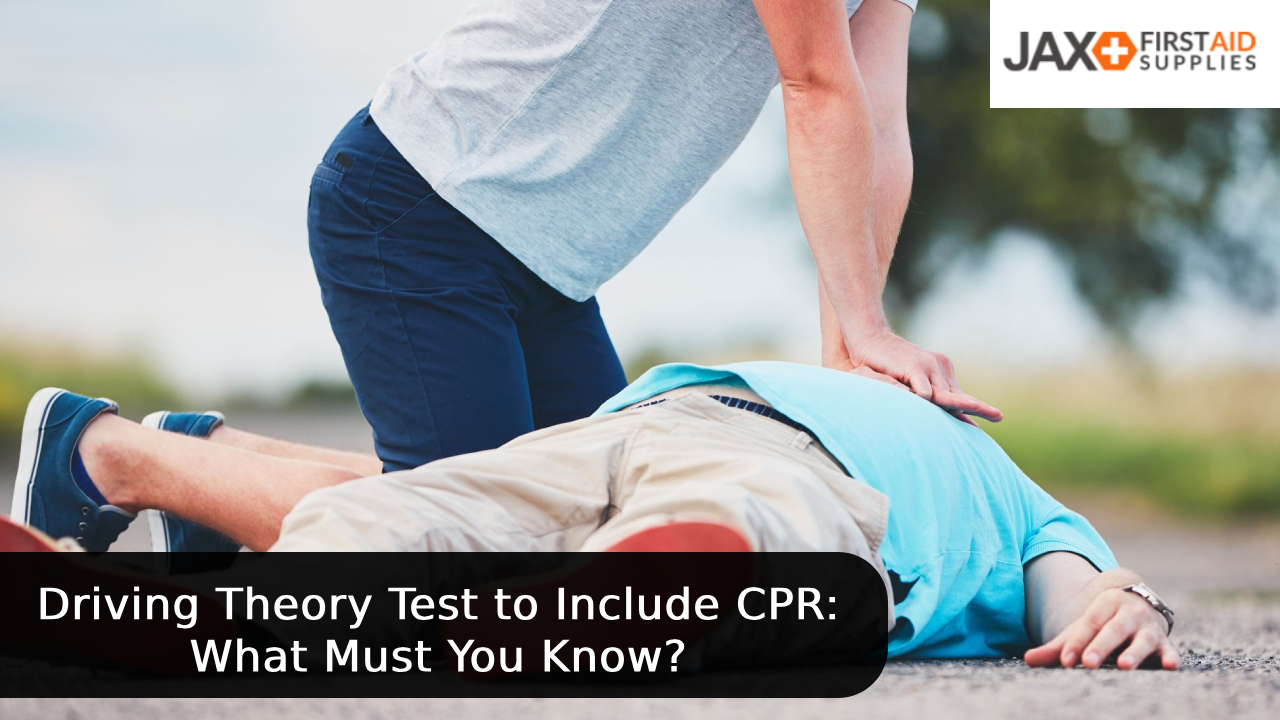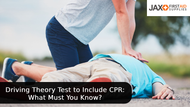Driving Theory Test to Include CPR: What Learner Drivers and First Aid Trainers Must Prepare For.
Published by Jax First Aid Supplies on 13th Aug 2025

From 2026, UK driving theory tests to include CPR & AED skills: What Should You Know?
The UK Driver and Vehicle Standards Agency (DVSA) has confirmed today that, starting in early 2026, CPR and AED use will become part of the car and motorcycle theory tests, which is taken yearly by approximately 2.4 million learner drivers. This means that every new driver will need to know how to perform the basics of CPR in an emergency situation, as well as the usage of AEDs.
The DVSA believes this large test update will help to encourage the broader public to uptake first aid and CPR training using highly realistic training devices such as a CPR manikin, normalising CPR readiness with road users, and ultimately increasing survival rates on the road. This addition to the car and motorcycle theory test marks a bold advance in road safety education, and helps to prepare the next generation of drivers to act accurately and quickly in an emergency, when every second counts.
What will learners study and be tested on?
From autumn 2025, before the official launch, learner drivers should begin familiarising themselves with tops such as CPR techniques, including the correct hand placement, compression depth (5–6cm for adults), and the recommended rate of 100–120 compressions per minute. They should also have a good knowledge on how to use an AED, including when to use one, how to turn it on, following the voice prompts, and safely delivering a shock to the individual.
These updates are already reflected in DVSA learning materials such as The Official DVSA Guide to Driving, and the Official DVSA Theory Test Kit App. Motorcycle publications are expected to follow.
Here are some example questions for the new DVSA driving test topics:
Q: An adult casualty is not breathing. To maintain circulation, CPR should be given. What’s the correct depth to press down on their chest?
- 1 to 2 centimetres
- 5 to 6 centimetres (correct answer)
- 10 to 15 centimetres
- 15 to 20 centimetres
Q: Who can use a public access defibrillator (AED)?
- Paramedics only
- First aiders only
- Doctors only
- Everyone (correct answer)
Q: Before using a public access defibrillator (AED), what is the first thing you should do?
- Remove any jewellery from the casualty
- Switch on the AED and follow the voice prompts (correct answer)
- Apply the pads without checking if the casualty is breathing
- Wait for a paramedic to arrive before switching it on
Cardiac arrest – Understanding the emergency
A cardiac arrest happens when the heart suddenly stops pumping blood around the body. The cardiac arrest will typically occur due to conditions such as dangerous heart rhythm disorders, a heart attack (where blood flow to part of the heart muscle is blocked, triggering abnormal rhythms), structural problems with the heart, severe blood loss or oxygen shortage, and other causes such as electrocution or even drug overdoses.
The signs that someone is in cardiac arrest will include factors such as the individual not breathing, being unresponsive to touch or speech, and show no movement. In these situations, the window for survival is measured in minutes. The chance of survival falls by around 10% every minute without immediate and accurate CPR and defibrillation.
About the theory test – What is actually changing?
The UK driving theory test is made up from two parts: 50 multiple-choice questions (covering everything from road signs to first aid) and a hazard perception video test. Candidates must score at least 43/50 on the multiple-choice section to pass, and they must pass both parts to move forward to their practical test.
The DVSA’s CPR and AED update will not add cost, time, or any difficulty to the test, but rather will simply refresh the existing first aid questions to reflect current best practice in CPR and AED use.
Why do drivers need these life-saving skills?
Other drivers on the road are typically the first on the scene in an emergency, whether at the site of a road traffic collision, a roadside collapse, or even a sudden cardiac arrest at a petrol station or service area. There are more than 40,000 non-hospital cardiac arrests in the UK each year, but fewer than 1 in 10 people survive, according to the Resuscitation Council UK
When CPR is given immediately and an AED is used within 3 to 5 minutes, the survival rate can skyrocket up to 70%. This makes bystander intervention essential in an emergency, especially in rural or roadside settings where emergency response may be delayed for some time. These are exactly the situations that new drivers may encounter, and why the DVSA’s focus on CPR is such an important public health development. However, it isn’t just new learner drivers that should familiarise themselves with this life-saving knowledge. If you are a driver of any age or experience, having the ability to perform CPR or use an AED in an emergency could genuinely save a life. The more road users that have this knowledge there are, the higher the survival rate will be for cardiac arrest on the road.
A new era for first aid trainers
For first aid and CPR trainers, this could be a crucial and important opportunity. With CPR and AED knowledge becoming a part of the driving theory test, trainers could potentially create tailored “Roadside CPR” courses aimed directly at learner drivers, with the possibility of partnering with local driving schools, running local community sessions, and offering specialist packages that allow trainers to meet the incoming surge in demand.
For your courses to align with the upcoming theory test content, it is very important to use practice materials that reflect real-world scenarios. Learners will benefit from hands-on experience that simulates real roadside emergencies, which can be greatly enhanced these with top-tier training tools:
- A CPR dummy with responsive feedback helps learners master compression depth and rhythm while simulating emergency response under time pressure, as well as a training AED.
- Use first aid training equipment such as Training dressing and Training triangular bandage to realistically simulate wound management as part of emergency scenarios.
- A complete First aid training pack, including bandages, gloves, face shields, and more, helps replicate the contents of a real-world emergency kit.
- Reinforce readiness with a robust First aid kit that shows what everyday drivers could realistically carry in a vehicle.
These tools can help to elevate the training from theoretical to practical, perfectly matching the new expectations of knowledge set by the DVSA’s updated theory test format.
A Defining Moment for Road Safety Education
The DVSA’s inclusion of CPR and AED questions in the driving theory test is more than just another update, but it is a complete cultural shift. As knowledge of first aid becomes a test requirement, we must give the next generation of drivers not just the knowledge of how to drive, but to protect other drivers on the road and respond to critical emergencies. For CPR trainers, this could mean a chance to reshape how they deliver instruction, scale their business, and make a huge difference in survival outcomes on British roads.







